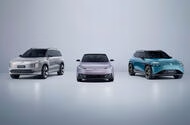China’s auto market is evolving at breakneck speed, and Volkswagen isn’t just keeping up—it’s doubling down. The German automaker recently unveiled three striking concept cars ahead of the Shanghai Motor Show, each developed in collaboration with its Chinese joint-venture partners. These models—the ID Era, ID Evo, and ID Aura—aren’t just design exercises. They’re the vanguard of a 30-vehicle offensive set to roll out in China over the next two years.
But why does this matter? Because China isn’t just another market for VW; it’s the battleground where legacy automakers are fighting to stay relevant against homegrown EV giants like BYD and NIO. Let’s break down what these concepts reveal about VW’s strategy and what they mean for the future of driving in China.
The ID Era: A Range-Extender SUV for Long-Distance Confidence
First up is the ID Era, a three-row, seven-seater SUV co-developed with SAIC. What makes it stand out? It’s VW’s first foray into range-extender technology—a hybrid setup where a combustion engine acts solely as a generator to recharge the battery, rather than directly powering the wheels.
This approach isn’t entirely new (think BMW i3 REx or the Chevy Volt), but VW’s execution promises a combined range of over 621 miles (1000 km) when both the fuel tank and battery are full. That’s a game-changer for Chinese consumers who still worry about charging infrastructure on long road trips.
The ID Era’s design borrows cues from the Tayron, but its real innovation lies in addressing range anxiety without sacrificing EV efficiency. For families or business travelers who need flexibility, this could be the sweet spot between pure electric and traditional hybrids.
The ID Evo: High-Tech Performance Meets Mainstream Appeal
Next is the ID Evo, developed by VW’s Anhui division. While it shares DNA with the Cupra Tavascan (sold in China as the ID Unyx), the Evo takes a more conservative approach to styling—think sleek hatchback rather than aggressive crossover.
Underneath, though, it’s anything but ordinary. The Evo debuts an 800V electrical architecture, a significant upgrade over the Tavascan’s 400V system. Why does that matter? Faster charging, lighter wiring, and better performance. Pair that with a zonal computing setup, and you’ve got a car that can handle advanced over-the-air updates and next-gen digital services seamlessly.
This suggests VW is serious about software-defined vehicles, a space where Tesla has long dominated. If the Evo delivers on its promises, it could help VW close the tech gap with its Silicon Valley rival.
The ID Aura: A Compact Sedan Targeting Budget-Conscious Buyers
Rounding out the trio is the ID Aura, a compact notchback saloon developed with FAW. At first glance, it might remind you of the old VW Bora, but this is no throwback. It’s the first model based on VW’s new Compact Main Platform (CMP), designed specifically for China’s cost-sensitive urban buyers.
The Aura is aimed at shoppers who might otherwise opt for tiny city cars, offering affordable entry into electrification without skimping on tech. While details on its powertrain are scarce, VW confirms it’s a New Energy Vehicle (NEV), meaning it could be a pure EV or a plug-in hybrid.
Given China’s tightening emissions regulations and growing appetite for budget EVs, the Aura could be a volume seller—especially if it undercuts rivals on price while delivering decent range.
Autonomous Driving: Level 2++ and Beyond
All three concepts come equipped with AI-powered autonomous driving systems. VW claims they’ll achieve “Level 2++” autonomy by next year, meaning they can handle most driving tasks—lane changes, merging, even overtaking—but still require driver supervision.
This isn’t full self-driving, but it’s a big step toward it. For context, Level 2++ sits between today’s advanced driver-assist systems (ADAS) and true hands-off autonomy. If VW can deliver on this promise, it could give the brand a crucial edge in China, where tech-savvy consumers increasingly expect smart features as standard.
Why China? And Why Now?
China is the world’s largest auto market, and NEVs now account for over 30% of new car sales. With domestic brands like BYD outselling foreign automakers, VW knows it needs to adapt—fast.
These three concepts signal a shift:
– Localized development: Partnering with SAIC, FAW, and its Anhui division ensures VW’s cars are tailored to Chinese tastes.
– Diverse powertrains: From range-extenders to 800V EVs, VW is covering all bases.
– Tech-first approach: Advanced autonomy and software updates are no longer optional.
The Road Ahead
VW’s 30-model blitz is ambitious, but the real test will be execution. Can these cars compete with China’s homegrown EV leaders on price, tech, and desirability? If the ID Era, Evo, and Aura are any indication, VW is betting big on flexibility, innovation, and local relevance.
For Chinese consumers, that means more choices—and for the auto industry, it’s a clear sign that the race for China’s future roads is heating up.
One thing’s certain: Volkswagen isn’t just playing defense. It’s going all-in.

